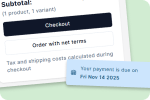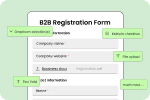Do you want to know how top wholesalers figure out prices that help their products sell quickly? Wholesalers have to handle special challenges when pricing, including bulk orders, changes in demand, competition, and customer bargaining. As a result, building a smart wholesale pricing strategy is absolutely necessary.
Proper pricing strategies help wholesalers earn more, compete in the market, and develop stable relationships with their clients. In this article, we’ll explore the 15 best wholesale pricing strategies to help you boost sales and grow sustainably.
Best Wholesale Pricing Strategy
Competitor-Based Pricing
Competitor-based pricing is the most common wholesale pricing strategy used by wholesalers operating in highly competitive markets. With this method, you decide your prices by observing what your competitors charge for their products. You must regularly review and analyze the market to make sure your prices are in step with what is happening in the industry.
Its main benefit is that it is easy to use. It sets a standard that allows customers to decide when there is little difference in products and prices. When your products are of the same quality and functionality, matching your prices stops potential buyers from opting for competitors just because they are cheaper.

Still, this wholesale pricing strategy has some issues that need to be addressed. Over-focusing on your competitors can lead you to overlook your expenses, what you offer, and how profitable you are. It may result in a situation where everyone keeps lowering their prices, which harms profits and the industry’s worth.
It’s necessary to carefully monitor your competitors’ prices to use this strategy well. In fact, rather than simply matching others’ prices, look at how your service, quality, or speed stacks up against theirs, and set your prices accordingly. If you use competitor-based pricing carefully, you can keep up with your competitors and still maintain a good level of profit.
>> Read more: How To Calculate Your Wholesale Pricing: Formulas & Tips To Set Up
Cost-Plus Pricing
Cost-plus pricing is the most straightforward and transparent wholesale pricing strategy. First, you find the cost to manufacture the product. Then, you add a fixed percentage to the total cost to find the price you will sell it for. This way, you profit from every sale, so it’s a safe and reliable approach, mainly for businesses with steady costs.
Before using cost-plus pricing, you need to be certain about your COGS, including all direct and indirect expenses, such as raw materials, shipping, warehousing, labor, and packaging. After you figure out the total cost, you add a pre-decided markup, which is generally from 20% to 50%, to determine your wholesale price. For instance, if the cost to make a product is $50 and you give it a 40% markup, it will end up selling for $70.
This strategy helps a lot when markets are predictable and prices do not move much. It also suits companies that aim to have stable and predictable profit margins. Sometimes, using this strategy can cause some trouble. When using cost-plus pricing, you risk missing out on profits since you don’t think about what customers are prepared to pay or what competitors charge. However, it is still a popular choice for wholesalers, mostly when used alongside other ways of setting prices that respond to market trends.
Surge Pricing (Dynamic Pricing)
With surge pricing, your prices can be adjusted at any time depending on the number of people looking to buy, how much you have, the season, or other things that affect the market. Unlike fixed pricing, dynamic pricing helps wholesalers benefit from changes in demand. They can make more money when demand is high and reduce prices when products are not in great demand to keep cash flowing.

For instance, a wholesaler of winter outfits might charge higher prices in the winter when demand goes up but lower them in the spring to sell the remaining stock. Likewise, if some products are hard to find in the market, you can increase prices to make more money than competitors dealing with supply problems.
To apply dynamic pricing well, wholesalers need to use data-driven technologies to track the market, customer actions, and prices from competitors. Businesses are now using AI systems such as SYMSON and Omnia Retail to react fast and keep their pricing as up-to-date as possible.
>> Explore: Best 20 B2B Ecommerce Examples: In-depth Review
Customer Value-Based Pricing
With this wholesale pricing strategy, businesses set the price of their product based on what the customer thinks it is worth instead of the costs of making it or the usual market price. It’s necessary to know what your customers need, what problems they face, and the amount they will spend on a useful solution.
This strategy is especially beneficial in wholesale for products that are not the same as others, offer special benefits, and are top-quality or unique. In this case, a wholesaler that offers environmentally friendly cleaning supplies to retailers might set a higher price, as many consumers will pay extra for such products. Also, a supplier that delivers high-performance items more quickly could charge more since the customer gains time savings.
To use this wholesale pricing strategy well, it is important to use data and insights. By using surveys, reviewing purchases, and using CRM, you can organize your buyers and see how they behave. AI tools can help analyze data based on buyer groups, historical sales, and competitor comparisons.
Key-Value Item Pricing
Key-value item pricing targets certain important products, known as KVIs, and sets their prices low to attract more customers. When customers decide if something is affordable, they refer back to KVIs and compare them with what other providers offer. They could include products that move very quickly or regular supplies that buyers usually buy in large amounts.

This wholesale pricing strategy works by giving great prices on only a few key items and using those prices to lure customers into believing you are priced lower than the competition. As soon as you successfully convince the buyer that your core products are well-priced, you can focus on selling items that offer a bigger profit.
For example, a wholesaler in the food business could offer cooking oil or rice at a price that covers its costs to attract many buyers, yet still make a good profit selling specialty items like imported spices.
Tiered Pricing
Tiered pricing is a way to arrange wholesale prices based on the number of products bought. As the order amount increases, the model makes it cheaper for customers to buy per unit. Customers are encouraged to purchase more, and your pricing process is made more efficient at the same time.
As an illustration, a wholesaler of packaging products may set up prices as follows: $10 for each unit when 1–49 are bought, $9 per unit with 50–199 units, and $8 per unit for 200 or more units. It gives larger customers an edge and also shows how much buyers can save if they order more, encouraging small buyers to increase their purchases. The feeling of getting a deal motivates buyers to make more purchases and spend more on each order.
The success of tiered pricing comes from matching the amount of discount given with how much profit the business can earn. Each tier should be set according to your expenses and aims, so that selling more items doesn’t reduce your profit.
Volume Discounts
Like tiered pricing, volume discounts give buyers a better price for purchasing a lot, but without fixed prices. On the other hand, discounts are given once orders reach certain amounts or when a particular period ends. It works best in B2B deals where the same buyers make large or regular purchases.
A distributor could give a 5% discount for orders greater than $1,000, 10% off for orders over $2,000, and an additional 15% for purchases over $5,000. Likewise, a building materials wholesaler often offers a discount for buying a certain volume in each quarter if the client spends more than $50,000. With these discounts, customers are motivated to buy many items or keep purchasing in the long run, which helps both sides.
By using volume discounts, wholesalers can get rid of their stock fast and keep the cash coming in. Nevertheless, you should pay attention to your discounts to make sure they do not reduce your profits. Offering discounts on larger orders is a good and flexible method to increase loyalty and sales in businesses where customers come back often.
Bundle Pricing
Sometimes, increasing the variety of products you sell all at once can help your business earn more revenue than selling just a single type. As an example of bundling, two or more related goods are sold as a single bundle at a better price. It allows wholesalers to increase the average size of each order and provides an easy experience for the buyer.
This way of selling works great when your products or services are a natural match. It inspires customers to make different purchases and speeds up the process of selling your inventory. Combining different items together also helps reduce customer tiredness by presenting convenient solutions instead of making them pick each item individually.
It’s important, however, that the bundles make practical sense for your target audience. Unrelated items or overly complex bundles may confuse rather than attract buyers. Done right, this pricing model strengthens customer trust and increases the perceived value of every transaction.
Geographic Pricing
Each market is unique, which means they shouldn’t all be priced the same. Geographic pricing takes into account that where a business operates can affect customer actions, expenses, and the level of competition. If you adjust your prices by location, you can respond to what each region’s customers expect.

This wholesale pricing strategy works well for wholesalers who service many cities, states, or countries. The way taxes, shipping, and demand change can be reasons to vary your pricing. For such deliveries to remote or costly regions, the company could charge a little more, whereas in cities where competition is tough, it may need to set lower prices.
Geographic pricing can be used by wholesalers if they look at local market trends, understand the cost differences, and check the strength of customer demand. You should keep buyers informed about why prices are set to ensure they trust and appreciate your honesty. Using geographic pricing allows you to sell your products in different markets without using the same strategy everywhere.
Time-Based Pricing
When setting prices, timing matters as much as the amount or product’s value. When using time-based pricing, marketers rely on people’s reactions during specific periods like seasons, holidays, or cycles to increase sales. Promotions can encourage people to buy and help get rid of excess stock when needed.
You can use either advanced deals or short-term offers to keep your products moving and your stock in balance. When buyers act fast, it leads to a faster sales process and more money flowing into the business.
It is important to choose when, what products to include, and how to communicate your time-based offers when creating these campaigns. Let your buyers know what they need to do and when, as well as highlight the benefits, so they want to act right away.
Psychological Pricing

Psychological pricing makes use of human reactions and views to affect what people decide to buy. Price is considered more as a feeling than an exact number for most buyers. When buyers are still influenced by cognitive biases, this wholesale pricing strategy has a gentle and significant effect on their decision-making.
Another technique is to use pricing that ends with “.99” or “.95,” making the prices less exact. For instance, when something is priced at $9.99 instead of $10, it seems much cheaper to people, even though the price difference is just one cent. Other ways include displaying a higher price next to a lower one and offering different price ranges, which often leads customers to choose a mid-range product.
For psychological pricing to be successful in wholesale, you must stay consistent and reliable. Although buyers are often concerned about price, they can still be guided by small details. You shouldn’t rely too much on these persuasive tools, because they may seem forceful if they don’t reflect your actual benefits.
Penetration Pricing
Using penetration pricing is a wholesale pricing strategy you can take to get customers interested in your new products right away. Companies using this strategy often price the product low at first, sometimes just to cover the costs, to enter the market, get more buyers, and affect the competition. It is very helpful for wholesalers who wish to break into competitive fields or present a new product to reluctant purchasers.
Offering products at a lower price encourages more people to buy and learn about the brand. After your products are being used regularly by a customer, you can start slowly raising the price or suggesting extra services. However, if used for too long, this strategy might bring down the value of what you offer and hurt your future income.
It’s necessary to plan how you will move your prices up once the low-price phase is over. Make sure you are able to manage a higher number of users without dropping your usual high quality or service level.
Skimming Pricing

Skimming pricing is the opposite of penetration pricing. Usually, businesses launch a new, exclusive, or differentiated product at a high price, and bring down the price step by step as more products are introduced and competition increases. This way, you can earn more from customers who buy your early version since they are willing to pay extra for being first.
Wholesalers may use this practice by offering the latest industrial equipment, secret ingredients, or small batches of limited-edition products. Because certain products are rare or only available for a certain period, early purchasers may be willing to pay more. With time, once more firms enter the market and the attraction fades, you decrease your prices to capture customers who care more about price.
When your product offers something better, has a well-known brand, or is innovative, skimming pricing is more useful. Even while reducing prices, it is necessary to manage expectations and maintain the item’s worth. As a result, early adopters don’t suffer any disadvantages, and your product remains appealing to customers who come later.
>> Explore more:
- Wholesale Electricity Pricing: Everything You Need To Know
- Diamond Wholesale Pricing – How To Calculate
- Spirits Wholesale Pricing: The Ultimate Guide
- 10 Wholesale Fashion Pricing Strategies to Maximize Your Profit
Contract Pricing
For major clients, long-term contracts give both a sense of security and access to valuable strategies. The model requires negotiating fixed prices for a certain period, such as six months to a year, in exchange for either an agreement for a set volume or exclusive rights to the supply. Trust and predictability are important in wholesale, so buyers and sellers often act this way.
Both bargains and assurance of steady orders attract buyers, and wholesalers gain a boost in demand and simpler logistics from contract pricing. It can also help both parties avoid the effects of market changes, including changes in raw material prices or currency rates. When it comes to manufacturing, agriculture, and construction, using contract pricing helps keep supply chains strong.
In making a contract, you need to remember to look at the price as well as when and how payments will be made, when products will be delivered, and if renegotiation is allowed. Creating strong contract pricing encourages businesses to maintain longer relationships with their partners.
Freemium or Loss Leader Pricing
While it is most common in SaaS and retail, freemium or loss leader pricing can also be applied in wholesale, mainly to attract new clients or inspire them to buy more later. With this wholesale pricing strategy, companies offer some products at a very low price, or even free, to get noticed and develop a trusting relationship.

This could happen where a company gives a free sample of a new product or offers a popular product at a discounted price to entice buyers. The idea is that any initial loss can be made up by additional orders, sales of extra products, or introducing other products. A wholesaler might sell a popular snack without making a profit to get their products on the shelf, then later present a greater variety to the same client.
Understanding your profit margins and planning what to do next is essential for loss leader pricing. A lack of strategy in product marketing may cause profits to decrease. However, when used carefully and for a specific goal, it helps businesses grow and attract more customers in the long run.
Additional Tips
Picking the best wholesale pricing strategies is necessary, but managing them well as time goes on is also significant. Here are some more ways to help you keep up with the fast-changing wholesale business:
- Leverage AI and machine learning tools to optimize your pricing: With the help of modern pricing software, businesses can analyze large amounts of information about customers, their own sales history, competitors, and trends in different seasons to choose the best prices for increased profits and sales.
- Regularly review and adjust your pricing strategies: Because things are always changing in the market, prices, competitors, and customer needs keep shifting. A strategy that was useful a year ago may not be as useful now. You should plan a time to review your pricing, watch your performance, and try new approaches if required. Following this process allows you to adapt while always keeping in line with your business objectives.
- Monitor industry trends and customer feedback consistently: You should keep an eye on what is happening in the industry and what customers say about your products regularly. You can learn if your prices are right by what your customers do and by what they say. Let’s check reorder rates, how much is being sold, and customer service inquiries to notice if there are pricing problems or if prices are working well.
And remember, pricing is never one-size-fits-all. With effective plans, good tools, and an active approach, you can thrive and develop steadily in wholesale.
FAQs
Wholesale pricing strategy refers to the approach businesses use to set prices for products sold in bulk to retailers or other businesses, aiming to balance profitability with attracting buyers and driving sales.
Cost-plus pricing involves adding a fixed markup percentage to the cost of the product to determine the wholesale price, ensuring a consistent profit margin.
Keystone pricing doubles the cost price to set the wholesale price, a simple method commonly used in retail and wholesale to maintain healthy margins.
Bundle pricing packages multiple products and sells them at a combined price, often lower than buying items separately, encouraging customers to purchase more items together.
Effective strategies include careful markup setting, market and competitor analysis, offering discounts strategically, and continuously reviewing prices to adapt to market changes.
Conclusion
Pricing in wholesale is something you need to keep changing, as it’s affected by your costs, your buyers, and the overall market. Depending on your objectives, the kind of product you sell, and your buyers’ behaviors, you can choose from the 15 different wholesale pricing strategies mentioned.
Let’s try some new strategies, adapt, and keep developing. When you have the right pricing, you meet your expenses, gain clients’ trust, motivate bigger purchases, and gain your long-term success. Visit B2Bridge.io to find out more about B2B Ecommerce.
Hi, I’m Ha My Phan – an ever-curious digital marketer crafting growth strategies for Shopify apps since 2018. I blend language, logic, and user insight to make things convert. Strategy is my second nature. Learning is my habit. And building things that actually work for people? That’s my favorite kind of win.







